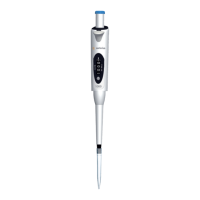12
testing routine for their pipettes with regard
to accuracy requirements of the application,
frequency of use, number of operators using
the pipette, nature of the liquid dispensed and
the acceptable maximum permissible errors
established by the user. (ISO 8655-1.)
12.1. Testing the performance
Performance testing should take place in a
draught-free room at 15 - 30°C, constant to
+/- 0.5°C and humidity above 50%. The pipette,
tips and the test water should have stood in the
test room a sufficient time (at least 2 hours) to
reach equilibrium with the room conditions. Use
distilled or deionised water (grade 3, ISO 3696).
Use an analytical balance with a readability of
0.01 mgs. (ISO 8655-6.)
Weighing
1. Adjust the desired test volume V
s
.
2. Carefully fit the tip onto the tip cone.
3. Fill the tip with test water and expel to waste
five times to reach a humidity equilibrium in
the dead air volume.
4. Replace the tip. Pre-wet the tip by filling it
once with test water and expel to waste.
5. Aspirate the test water, immersing the tip
only 2-3 mm below the surface of the water.
Keep the pipette vertical.
6. Withdraw the pipette vertically and touch
the tip against the inside wall of the test
water container.
7. Pipette the water into the weighing vessel,
touching the tip against the inside wall of
the vessel just above the liquid surface at an
angle of 30° to 45°. Withdraw the pipette by
drawing the tip 8-10 mm along the inner wall
of the weighing vessel.
8. Read the weight in mgs (m
i
).
9. Repeat the test cycle until 10 measurements
have been recorded.
10. Convert the recorded masses (m
i
) to volumes
(V
i
)
V
i
= m
i
Z Z = correction factor (Table 1)
11. Calculate the mean volume (⊽) delivered:
⊽ = (∑V
i
)/10
12. For conformity evaluation calculate the
systematic error e
s
of the measurement:
in µl: e
s
= ⊽ - V
s
V
s
= selected test volume
or in %: e
s
= 100 (⊽ - V
s
)/V
s

